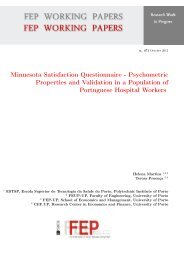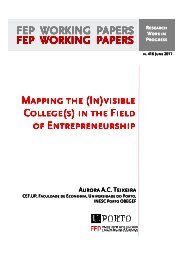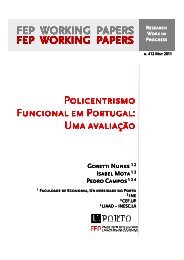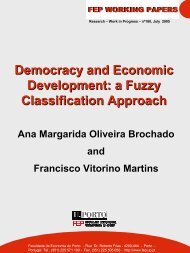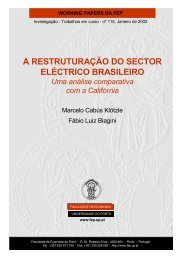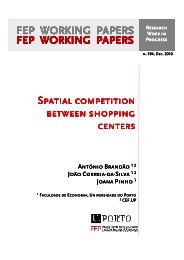Ant Colony Optimization: a literature survey - FEP - Working Papers
Ant Colony Optimization: a literature survey - FEP - Working Papers
Ant Colony Optimization: a literature survey - FEP - Working Papers
You also want an ePaper? Increase the reach of your titles
YUMPU automatically turns print PDFs into web optimized ePapers that Google loves.
given by:P kij(t) =∑ατ ij (t) + βη ij[ατ ij (t) + βη ij ] . (37)j∈J k iThe strategy is defined to prevent a domination of the pheromone trails in the ants decision, byincorporating an additive form instead of the usual multiplicative form. This way, the authorexpects both pheromone and heuristic information to have an active role in the decision. Thisnew transition rule comes with a modification of the heuristic value, which is a simple scalingprocedure given by:η s ij =η ijmax(η ij ) , (38)making every value to be between zero and one regardless of problem size, a difficulty whichwas already mentioned before.A probability function based on the one developed by Maniezzo (1999) for the Quadratic Assignmentproblem is used within an algorithm developed to solve single row layout problemsby Solimanpur et al (2005). The function also presents an additive scheme but eliminates thenecessity of the parameter β associated to the heuristic valueP kij (t) =∑ατ ij (t) + (1 − α)η ij[ατ ij (t) + (1 − α)η ij ] . (39)j∈J k iIn this case, it is clear that α must be a number between zero and one, and not any positive numberas was the case of the original method. Therefore, if one wishes to prioritize the pheromoneinformation one is implicitly decreasing the importance of the heuristic information, and viceversa,and there is only one value for which they have the same weight, which is 0.5.Blum and Blesa (2005) introduced some changes to the transition rule defined for the <strong>Ant</strong><strong>Colony</strong> System (ACS), earlier developed by Dorigo and Gambardella (1997), in order to solvek-minimum spanning tree problems. An ant starts its solution by randomly choosing the firstarc to enter the solution tree. Then, at each step of the construction, the next arc a to be added ischosen deterministically if q ≤ 0.8, and probabilistically if q > 0.8, according to equation (40):⎧⎨a =⎩{ }τaarg minw(a) : a ∈ A NH(S t−1 )if q ≤ 0.8l if q > 0.8,(40)where τ a is the pheromone in arc a, w(a) is the weight of arc a, A NH (S t−1 ) is the set of all arcsthat do not belong to solution S t−1 and have exactly one end-point in S t−1 , and where19



